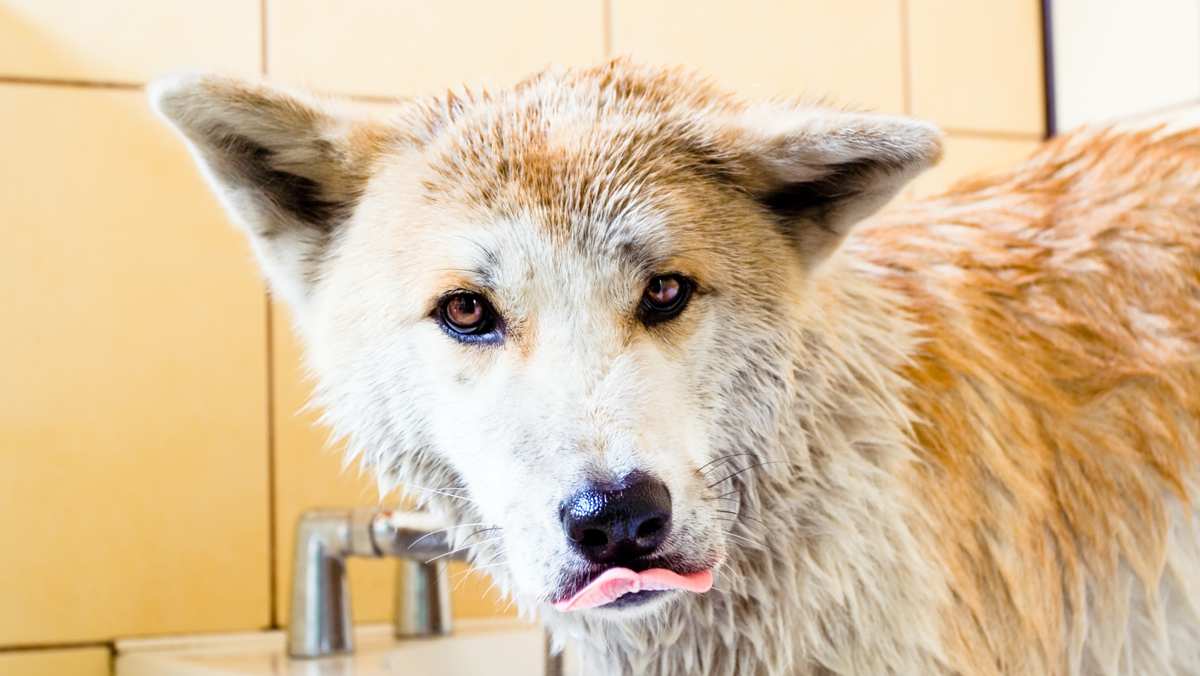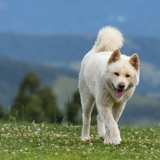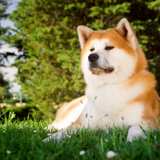Akita Grooming
Akitas have thick, medium-length double coats that are generally easy to maintain. See below for info on Akita coat care, brushing, other maintenance, and for reasons an Akita should never be shaved.

Akitas have thick, medium-length double coats that are generally easy to maintain. See below for info on Akita coat care, brushing, other maintenance, and for reasons an Akita should never be shaved.
Akitas' plush, medium-length double coats don't really mat or tangle; though the breed sheds moderately (and heavily during the twice-yearly shedding season), aside from regular brushing, Akita grooming is not a time-consuming process. These dogs require brushing once or twice per week; a few Akita grooming tools are needed. (The brushing process is explained in more detail in the Brushing section of this page.) Akitas will also need baths about once a month. And though Akita organizations and professional groomers advise against shaving an Akita, some of the longer-haired breed members will be okay if their outer coats are scissored.
Baths can be given in a bathtub, or possibly in an outdoor kiddie pool using a garden hose. To bathe an Akita: first give the dog a complete brushing, then wet the coat thoroughly (which can be tricky, as Akitas have waterproof coats; if needed, run your hands through the fur to make sure it's nicely soaked). Starting at the dog's topline, apply a good amount of canine shampoo (available at pet stores); lather thoroughly, making sure to include the legs, then rinse completely. Towel-dry the coat, then finish with a quick brush-through to make the coat look fresh and clean.
As previously stated, breed experts strongly recommend not shaving an Akita. (More information can be found in the Styling & Haircuts section.) A few of these dogs have medium- to long-haired coats, and can have their fur trimmed with scissors; it's best to let a professional groomer handle this process, and along the way the groomer can provide tips on how to groom an Akita in general.
Akitas need brushing at least once per week (and 2-3 times a week during the spring and fall shedding seasons). It's best, groomers say, to start brushing the dog at a young age, so it can get used to the practice. For most of the year, the best Akita brush is a wide pin brush. During shedding season, it's better to use a rake brush, as this collects more of the dead hairs.
To brush: first wet the coat with mist from a spray bottle. Then, starting at the shoulders, brush the fur section by section using a deep, sweeping motion with the pin brush or rake to reach the dead hairs in the undercoat. Brush in the direction of hair growth. Move backward and downward until the entire coat is brushed, finishing with the legs.
If desired, go over the coat again with a wide-toothed comb to give the coat a nice finishing touch.
Akitas have double coats of hair that are generally patterned in a fashion that can quickly and easily make an ungroomed dog look unkempt. Regular and proper brushing will help to prevent tangles and mats in your Akita's coat. And while there are two varieties of Akita, Japanese and American, this has to do with color. Both of these variations can have either the standard or long coat, and that's where you should know about the differences in coat care.
There are also certain areas where mats and tangles can easily happen due to the dog's activity, movement, and debris collection. The thighs, the tail, and the area under the tail need to be carefully and frequently brushed. The hair intersects around the thighs and base of the tail in a way that can prompt tangles, and the area around the anus can catch poop and do the same. The horror stories of massive mats happening after just a couple or three missed sessions can be found online. Don't neglect this brushing requirement for more than a day!
One of the best mat removing tools is a de-matting comb or a rake. This alone won't do the trick, however, as the coat must be made ready for it. Using a de-tangler spray aids in removing the mats with keeping your Akita comfortable and enjoying the grooming session. The slick coating of such sprays will help the comb's teeth slide through rather than pull, tear, or rip out the tangles.
Before you do all that, it's best to use a slicker brush or glove to help remove the dead hair and to find any mats or tangles just forming. The last step, after using a de-tangler spray and brush combo described above, is to use a flea comb or other very fine-toothed comb to slowly and gently make sure there are no tiny tangles you may have missed.
Here are some tips for when you get down to business of "furminating" tangles and mats from your Akita's coat:
Whether you have an Akita Inu (the Japanese Akita, which is the original breed) or an American Akita, bathing is a small part of overall grooming. These dogs have a very protective double coat that basically cleans itself due to the harsh guard hairs and the extremely thick, plush and nearly impenetrable undercoat. The natural oils that help protect the hairs from damage and dirt can themselves be damaged from frequent bathing, harsh or improper shampoos and hot air dryer heat. In addition, the dog's tongue, like all dogs, is itself a cleaning tool that can be relied upon instead of bathing.
Still, there are times when your Akita needs a proper bath because she has gotten into the mud, the snow, or both, if not something worse that makes her smelly. This calls for a number of steps, both preparatory and executive — meaning you don't just plop her in a tub of water, squirt on some Akita shampoo, and then towel her off. Most Akita owners say that a bath two to three times a year is fine, and that more than that can start breaking down the coat's protective oils.
Of course, the first thing you need to do is the shampoo. Never use human shampoos with any dog. For many breeds, there are often shampoos that are basically breed-specific or for specific coat types. Whether you use an akita shampoo or not, always use a natural shampoo specifically formulated for dogs. These shampoos are free from harsh chemicals and detergents which strip the healthy oils from your Akita's skin and coat. Weekly brushing helps to promote clean healthy skin and coat and stimulates production of the naturally protective oils.
Everything else is basically, well, basic:
Start with the grooming procedures from the previous sections to remove as much dirt and dead hair as possible. Then rinse the coat and get it wet to the skin. Next is a thorough application of shampoo which should be gently worked in by hand. Now comes the long part: rinsing. You don't want to leave any shampoo behind, and you don't want to rush the rinse either. Once this is all done, it's time for drying. Start with the towels, and be sure to get her as dry as possible within a reasonable amount of time. Whether you use an air dryer is up to you as is the type of dryer. Human hair dryers are not recommend as they can get very hot and damage the Akita's oils and burn her skin. Finally, and this is also up to you if you want to do it, is to apply a leave-in conditioner. There are many kinds of these dog conditioners, and you should consult a groomer, your vet and other Akita owners to get some advice on them and adjust to your preference.
Giving an Akita a haircut is a risky proposition. Akita breed club members and professional groomers alike agree that an Akita should under no circumstances have its fur shaved to less than 1.5-2 inches; doing so, they say, will make the dog's skin prone to sunburn and irritation, and the coat simply won't grow back correctly.
Two ideas that are misunderstood by many owners are that shaving an Akita will minimize shedding, and will keep the dog cooler. According to experts, the shed hairs are from the dog's undercoat, much of which remains when the dog is shaved. In addition, an Akita's coat at full length acts as natural insulation, trapping cooler air beneath the coat in hot weather as well as the opposite in cold temperatures. Shaving an Akita, therefore, will have no affect at all on the dog's body temperature.
A few Akitas, however, do have longer outer coats that can be 3-4 inches in length. These "Longcoat" Akitas, as they're called, can have their coats trimmed and neatened with scissors by a groomer to minimize their "shaggy" appearance. Otherwise, Akita enthusiasts recommend that dogs of this breed do not receive proper haircuts or stylings.
Akita teeth, ears, and nails also need regular maintenance. Use the following tips to care for your dog in these areas:

See the complete guide on how to care for Akitas.
Go to the Previous Page
Check out Akita pictures. See breed coloring, coats, and Akitas at different ages
Go to the Next Page